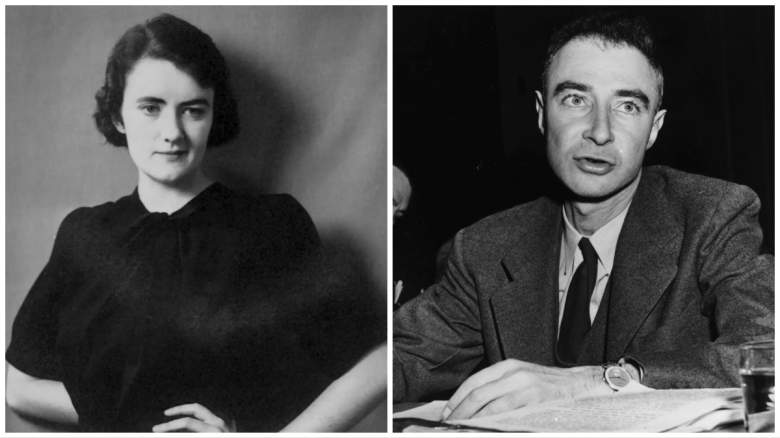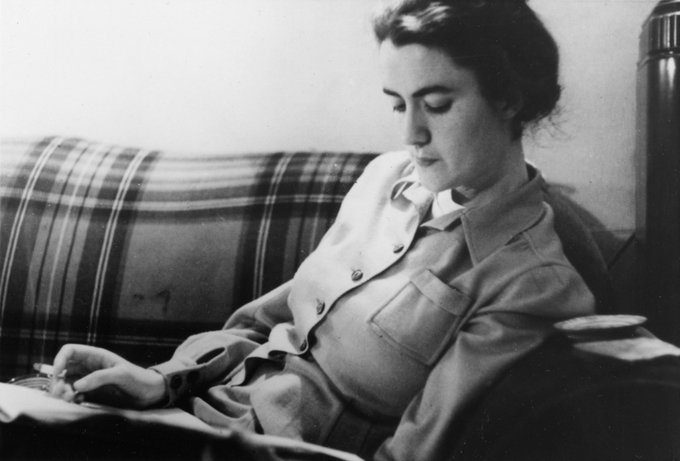
Library of Congress/Getty Jean Tatlock and Robert Oppenheimer.
Jean Tatlock was the real-life mistress of famed scientist J. Robert Oppenheimer. She is featured in the new movie “Oppenheimer,” played by actress Florence Pugh.
This article will contain some spoilers for the movie.
In real life, as with the movie, Tatlock was found dead in a bathtub. Whether she committed suicide or was murdered is the matter of some conjecture. Her death certificate has been published online.
According to Biography.com, Tatlock’s cause of death was ruled a suicide. She was found dead “on January 4, 1944, at age 29. Her father discovered her body after entering her San Francisco apartment through a window after she didn’t respond to the doorbell. He found her lying in the bathroom, her head submerged in a partially-filled bathtub, with a suicide note on the dining room table,” Biography.com reports.
However, questions remain about her death.
The book on Oppenheimer, American Prometheus: The Triumph and Tragedy of J. Robert Oppenheimer, states of Tatlock, “Jean was Robert’s truest love. He loved her the most. He was devoted to her.” The movie is based on that book, according to its Amazon page. As is depicted in the movie, Oppenheimer married someone else.
Here’s what you need to know:
J. Robert Oppenheimer Was Involved With Jean Tatlock for 7 Years

GettyAmerican atomic scientist Julius Robert Oppenheimer (1904 – 1967)
As is featured in the movie, in real life, a personnel security board for the U.S. Atomic Energy Commission stripped Oppenheimer of his security clearance. That board’s report discusses his relationship with Tatlock.
“It was reported that in 1943 and previously you were intimately associated with Dr. Jean Tatlock, a member of the Communist Party in San Francisco, and that Dr. Tatlock was partially responsible for your association with Communist-front groups,” the report says.
The Board concluded “that this allegation is true,” noting,
Dr. Oppenheimer in his testimony before this Board admitted having associated with Jean Tatlock from 1936 until 1943. He stated that he saw her only rarely between 1939 and 1943, but admitted that the association was intimate. He admitted having seen Jean Tatlock under most intimate circumstances in June or July of 1943, during the time when he was Director of the Los Alamos Laboratory, and admitted that he knew she had been a Communist and that there was not any reason for him to believe that she was not at that time still a Communist. He named several Communists, Communist functionaries or Communist sympathizers whom he had met through Jean Tatlock, or as a result of his association with her.
According to the Atomic Heritage Foundation, “Tatlock met J. Robert Oppenheimer in 1936 while she was studying at the Stanford University Medical School. By this point, she was already an active member of the Bay Area’s Communist community. She is credited with introducing Oppenheimer to this community, initiating his connections to radical politics that would eventually lead to the revocation of his security clearance almost twenty years later.”
Jean Tatlock Was Found Dead in 1944, Lying on a Pile of Pillows at the End of a Bathtub

Library of CongressJean Tatlock
The movie loosely follows Tatlock’s real death scene, showing her drowning herself in a bathtub.
According to Nuclear Secrecy blog, citing the American Prometheus book, “Tatlock’s father discovered her dead, having broken into her apartment after a day of not being able to reach her. He found her ‘lying on a pile of pillows at the end of the bathtub, with her head submerged in the partly filled tub.'”
The Atomic Heritage Foundation article notes, “Tatlock broke off the relationship in 1939, but Oppenheimer visited her in San Francisco as late as 1943. Tatlock, who suffered from depression, was found dead on January 5, 1944. Some have suggested foul play was the cause, but most historians have concluded that she most likely committed suicide.”
According to the Huffington Post, printing an excerpt from “An Atomic Love Story: The Extraordinary Women in Robert Oppenheimer’s Life,” Oppenheimer did meet secretly with Tatlock in 1943.
Robert met Jean on that early summer day in 1943 just as work on the atomic bomb was beginning on a secret plateau in New Mexico. He was only a few weeks into the work when he had to return to U.C. Berkeley to recruit young scientists. It was then that he decided to keep a promise he made to see the young woman he would always describe as ‘a lyrical, uplifting, sensitive, yearning creature.’ Their reunion lasted scarcely 24 hours, but would prove to be pivotal — and detrimental in ways he couldn’t imagine — to the career of the man credited with leading the effort to produce the first weapon of mass destruction.
The blog continues,
He found her suicide note, which read: ‘I am disgusted with everything… To those who loved me and helped me, all love and courage. I wanted to live and to give and I got paralyzed somehow. I tried like hell to understand and couldn’t… I think I would have been a liability all my life—at least I could take away the burden of a paralyzed soul from a fighting world.’
The American Prometheus authors wrote, according to the blog:
According to the coroner, Tatlock had eaten a full meal shortly before her death. If it was her intention to drug and then drown herself, as a doctor she had to have known that undigested food slows the metabolizing of drugs into the system. The autopsy report contains no evidence that the barbiturates had reached her liver or other vital organs. Neither does the report indicate whether she had taken a sufficiently large dose of barbiturates to cause death. To the contrary, as previously noted, the autopsy determined that the cause of death was asphyxiation by drowning. These curious circumstances are suspicious enough—but the disturbing information contained in the autopsy report is the assertion that the coroner found ‘a faint trace of chloral hydrate’ in her system. If administered with alcohol, chloral hydrate is the active ingredient of what was then commonly called a ‘Mickey Finn’—knockout drops. In short, several investigators have speculated, Jean may have been ‘slipped a Mickey,’ and then forcibly drowned in her bathtub.
According to Today, “Some, including Tatlock’s brother Hugh, have speculated that her death was a result of foul play by intelligence agents from Los Alamos, but no evidence has been found to support this theory.”
An autopsy revealed that Tatlock had barbiturates and traces of the sedative chloral hydrate in her system when she died. Her cause of death was listed as suicide. Her father burned her letters and photos before the police arrived, destroying documents that might have provided a clearer view into her affiliation with the CPUSA. Some people, including Tatlock’s brother, Hugh, speculated that she had been murdered, possibly by intelligence agents from Los Alamos; no definitive evidence to support that theory was uncovered.
READ NEXT: The Real Story of J. Robert Oppenheimer.
